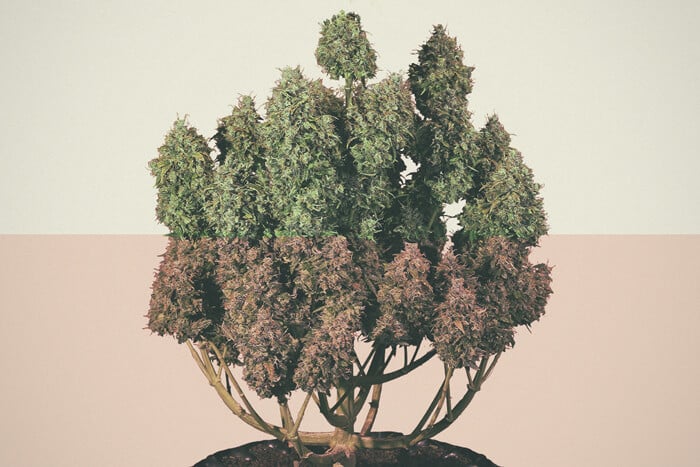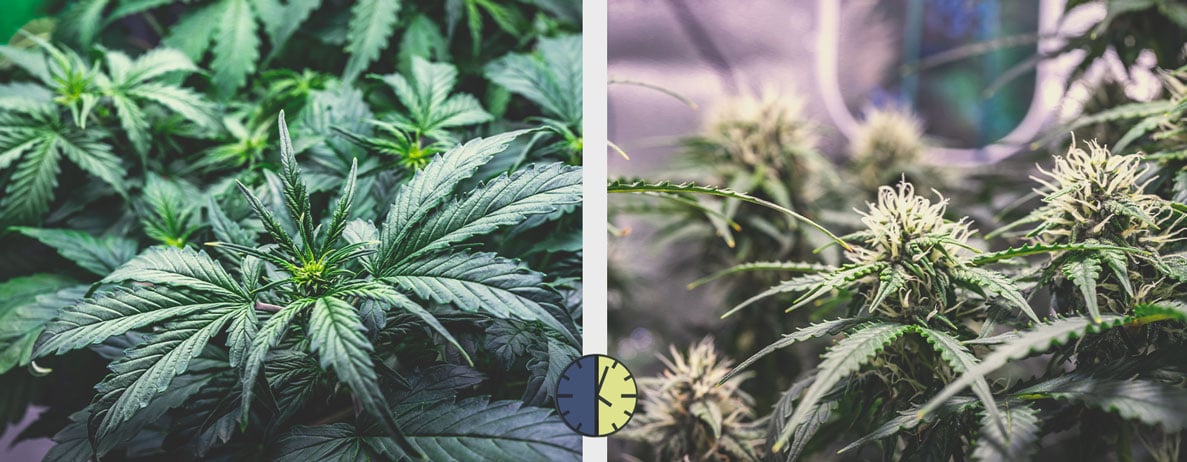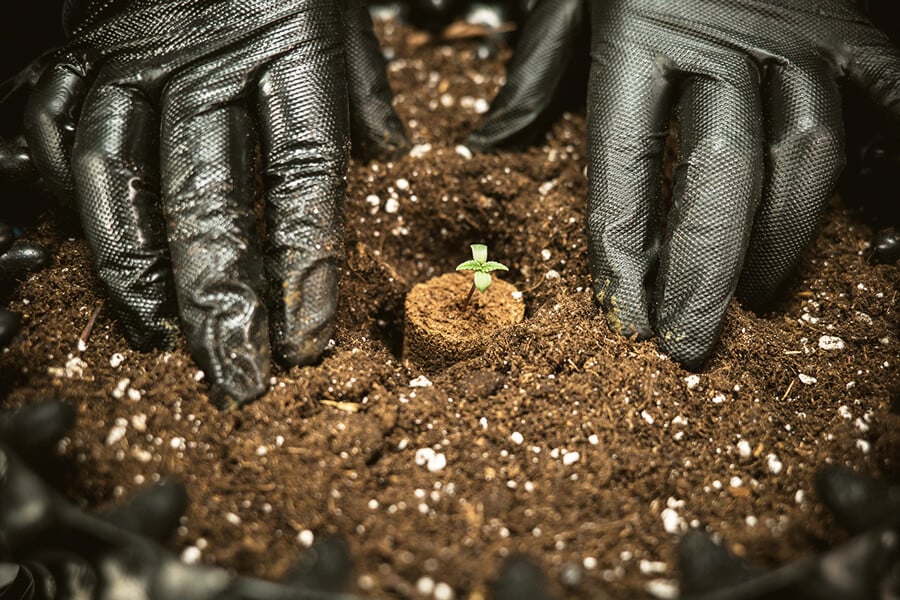.

The Pros And Cons Of Autoflower Cannabis Strains
Autoflowering strains are the go-to genetics for beginner growers and those looking for a fast return. But they're not perfect. Find out what makes them great, and where they run into issues.
Modern cannabis growers are spoiled for choice. There are more strains on the market than ever before, and many growers have taken a liking to the new and improved selection of autoflowers.
Autoflowering genetics have a lot to offer. There are varieties high in CBD, high in THC, and those with a nice balance of both. That’s not to mention the incredible diversity in terpene profiles.
But it’s not all sunshine and roses. Autoflower strains have a host of advantages, but they also carry disadvantages that turn some growers off.
WHAT IS AUTOFLOWER CANNABIS?
What makes autoflowering cannabis different from other types? Well, the key difference resides in the name. Put simply, these strains flower automatically.
There are two main phases of the cannabis growing cycle: the vegetative phase and the flowering phase. Another type of cannabis—known as photoperiod cannabis—requires a shift in the light cycle to trigger flowering. Autoflower strains do away with this inconvenience. They don’t rely on external cues to start producing resinous buds. Instead, they flower after a certain amount of time has passed.
The autoflowering trait didn’t emerge by accident. It occurred as an adaptation to environmental conditions. You’ve probably heard of Cannabis indica and sativa. Well, the autoflowering gene arose in Cannabis ruderalis.
The ruderalis subspecies adapted to the cold and often harsh environments of Central Asia, Eastern Europe, and Russia. These regions feature a considerably shorter growing season and colder temperatures. For this reason, ruderalis abandoned the strategy of waiting for the seasons to change to trigger flowering. Instead, the subspecies developed an autoflower gene to ensure reproduction before the temperature plummets.
Thanks to this adaptation, growers now enjoy the speedy growth of autoflowering genetics!


AUTOFLOWERING VS FEMINIZED
You’ve probably seen the term “feminized” used frequently as you browse the internet for all things cannabis seeds. Both autoflower and photoperiod strains can be feminized. All it means is that a breeder modified a particular strain to produce only female plants. Technically speaking, the odds of a female emerging are 99.9%—that’s still quite impressive!
Breeders produce feminized seeds through various techniques that are discussed in detail here. Just keep this in mind: pick up a pack of feminized seeds if you want nothing but buds!
|
Pros |
|---|
|
Pros |
|---|
Autoflower strains have a long list of advantages over photoperiod varieties. Their short life cycle attracts growers seeking prompt gratification, and their hardy nature makes them suitable for beginner cultivators and veterans alike.
-
FASTER LIFE CYCLE
Autoflower cannabis varieties are queens of speed. This trait is another result of their adaptive prowess. Most autoflowering strains complete the entire growing cycle in the same amount of time that photoperiod strains take to finish flowering alone—around 7–10 weeks. Their speedy life cycle results from a brief vegetative phase and a fast flowering stage.
Growers rarely cultivate pure ruderalis strains outside of breeding operations as these varieties produce very little in regards to yield. However, by breeding successful photoperiod strains with ruderalis genetics, breeders can create autoflowers, and therefore faster, versions of legendary varieties. For example, Haze genetics are known for their brilliant sativa effects, but their long flowering times can be a turn-off. The merging of Haze and ruderalis genetics means growers now have access to these sativa effects in much less time.
The speed of autoflowers appeals to growers with a penchant for near-instant results. Waiting for a crop to ripen can be teasing at best and excruciating at worst. If you tend to autumn on the impatient side, autoflowering strains are the way to go.
The brevity of autoflowers also appeals to cultivators who grow under pressure. They can support faster turnover for commercial operations, allowing for perpetual harvests indoors.
Again, most autoflowers will race from seed to harvest in around 7–10 weeks, so growers can time their next wave of seedlings in conjunction with the previous harvest.
Cultivators can also maximise yields by using the sea of green (SOG) technique. This method involves planting numerous autoflowers in close proximity and manipulating them to converge into one large, productive canopy.
Here are a few of the fastest autoflowers around:
-
DISCREET PLANTS
Autoflowering cultivars typically reach a height of between 60–100cm. Their compact size and impressive speed enable clandestine cultivators to set up and dismantle their operation in as little time as possible.
You can easily grow autos on balconies and in hidden locations in your garden. They’re also popular among guerrilla growers—cultivators that grow cannabis in hidden public or wild locations. This method helps to keep crops out of sight and hidden from thieves.
If you’re looking for the stealthiest possible way to grow, give micro-growing a go. The goal here is to keep plants as small as possible while still achieving a reasonable yield. It goes without saying that autoflower varieties are perfectly suited to this method.
More extreme examples of micro-growing include cultivating tiny plants in modified computer towers, buckets, and boxes. Growers often use low-stress training to keep plants small and under control.
Here are a few of the stealthiest autoflowering strains available:
-
SIMPLE LIGHTING DEMANDS
Autoflower growers typically elect to use a simple light schedule of 18 hours on and 6 hours off for the entire duration of the life cycle. Such a schedule provides plants with an adequate amount of light while saving on energy.
The simple lighting demands of autoflowering strains serve as another advantage. As we mentioned above, they don’t require a change in light schedule to begin flowering. This trait allows growers to be extremely flexible with lighting.
Growers who don’t mind splashing out on expenditures might choose to run their lights for 24 hours. Some cultivators report more explosive vegetative growth and enhanced yields using this method. Others argue that a 24-hour schedule might deprive plants of their natural resting period. A schedule of 12 hours on and 12 hours off occupies the other end of the spectrum. It’s the best option for growers looking to save money, but yields won’t be as impressive.
Regardless of the schedule, the lighting demands of autoflower strains are easier to meet than those of their photoperiod counterparts.
-
RESILIENT PLANTS
Autoflower plants boast strong, sturdy, and resilient genetics. Cannabis ruderalis didn’t survive the throes of northern latitudes by chance. The subspecies is well equipped to deal with extreme temperatures and harsh weather.
The very name “ruderalis” stems from the Latin word “rudus”, meaning rubble. The subspecies appears in urban settings thriving in broken ground, close to demolished buildings, and in roadside ditches. The majority of autoflowers can fend for themselves. They laugh in the face of pest infestations and do well to defend against yield-ruining mould.
Their impressive resilience makes them well-suited for novice growers as they’re extremely forgiving of beginner error.
-
NO PROBLEMS WITH LIGHT POLLUTION
Growing autoflowers means you can be a lot more relaxed when it comes to light pollution. In fact, it’s a complete non-issue.
Light pollution has the potential to screw up a photoperiod growing operation completely. Bright street lights can prevent outdoor plants from initiating flowering. Indoor growers also experience this inconvenience. They need to make sure that their photoperiod plants grow in the absence of unnecessary light. A leaky grow tent is all it takes to mess up a light schedule.
Fortunately, autoflowering plants don’t autumn prey to this irritating occurrence. They don’t obey the command of external lighting cues—they run on their own time.
-
FEWER NUTRIENTS NEEDED
Autoflowering strains thrive in less-nutritious soil. Their speedy growth and small stature mean they don’t require much fertiliser.
Autoflowers simply aren’t as hungry as their photoperiod counterparts—another result of their hardy nature. Whereas photoperiod strains require a complex nutritional strategy that changes throughout the growing cycle, autoflowers can make do with the bare minimum.
Here’s a basic recipe for a good autoflowering soil mix:
| 3 parts peat moss | 3 parts compost |
| 2 parts perlite, moistened | 1 part vermiculite, moistened |
| 3 parts peat moss | 3 parts compost | 2 parts perlite, moistened | 1 part vermiculite, moistened |
-
HIGHER CBD PERCENTAGE
Autoflowers tend to offer higher levels of CBD. While some cannabis users only value THC, many others prefer equal or higher concentrations of CBD. The non-psychotropic cannabinoid provides a pleasant recreational effect characterised by a clear-headed and lucid feeling.
Many medicinal users also benefit from higher levels of CBD. The cannabinoid provides effects that help to take the edge off of many conditions.
Breeders have managed to ramp up the CBD levels of many famous hybrids by infusing them with Cannabis ruderalis genetics.
Check out these autoflowers with high CBD levels:
| Cons |
|---|
| Cons |
|---|
The truth is: nothing is perfect. Despite all of their impressive qualities, autoflowering genetics don’t escape this law of reality.
-
LOWER YIELD
The small size and short life cycle of autoflowers come with a tradeoff: smaller harvests. Their compact stature means they can’t produce as many bud sites as a taller photoperiod plant. Outdoor yields usually clock in at around 80–180g/plant.
Some photoperiod sativa giants grow into what look like trees, whereas indicas put out incredibly dense and fruitful canopies. Most autoflowers don’t exceed 1m in height, and their canopies bloom fewer buds.
Additionally, there are only so many buds an autoflower can put out over such a short flowering time. Photoperiod strains have time to mature into highly productive specimens. Autoflowers, on the other hand, have to put out what they can before their short lifespan comes to a close.
-
COST OF LIGHTING
You’ll save money on nutrients, but you’ll likely end up spending more on lighting. This fact doesn’t bother some growers, who treat their autoflowers to a permanent 24-hour light cycle.
Other cultivators aim to spend as little as possible on lighting. Autoflowering strains require a bare minimum of 12 hours on and 12 hours off. While growers can save money doing this, they will pay the price in the form of smaller yields.
In contrast, highly productive photoperiod strains only require a schedule of 12 hours on and 12 hours off to trigger flowering. Growers need to abide by this schedule during the entire flowering phase, meaning they’ll save money and produce bigger yields while doing so.
-
LOWER THC CONTENT
Some cultivators are put off by growing autoflowers because of their perceived low THC levels. It’s true; old-school autoflowers did struggle to compete with highly psychoactive photoperiod strains.
However, Royal Queen Seeds has unleashed a new generation of autoflowering genetics. These newer strains produce THC levels that rival many of their photoperiod counterparts.
Check out these high-THC autoflowers:
-
POOR-QUALITY CLONES
Unfortunately, autoflowers don’t produce good-quality clones. Because clones are an exact copy of the mother plant they came from, they even inherit the same age!
Let’s say that a grower collected a cutting from a two-week-old mother plant. This means the clone will have to vegetate, flower, and mature in a matter of ~5–6 weeks.
The end result will be an underdeveloped plant that hasn’t even reached the end of the flowering phase—or achieved a good size or yield—before the life cycle comes to a close.
-
NO TIME FOR RECOVERY
Autoflowers grow in a rapid, linear fashion. Their speedy traits make them highly convenient, but it also makes them risky to experiment with. Their brevity leaves very little time for recovery from major errors.
Growers of photoperiod plants can happily prune, train, and defoliate to their heart's content. If they make any large errors, they can just keep the plant in veg mode and wait for it to recover.
Autoflowers don't behave in this way. While you can train them, it’s risky business. If you cut too deep or accidentally damage a large branch or bud site, they’ll have next to no time to recover. They’ll stop vegging when they see fit.
As such, you need to be accurate when you train and manage autoflowers. Cut with care, because they’ll have no time to repair.
-
SHOULD BEGINNERS START WITH AUTOFLOWER CANNABIS STRAINS?
Autoflowering cultivars certainly provide an easier growing experience. As a beginner, avoiding complications and thoroughly enjoying the cultivation process will help you to develop your green fingers faster. Not only are autos stealthier and more resistant to pests and diseases, but they’ll also gift you with a harvest much quicker.
The downside? Not as much bud and less THC. Plus, growers can opt to keep photoperiod strains in the vegetative phase for as long as they please. This enables them to develop large and productive plants. Although it’s feasible for beginners to grow towering sativas, a lot more can go wrong in the process.
If you want to follow in the footsteps of many beginners that are now accomplished growers, find yourself some seeds and check out our autoflowering grow guide.







































